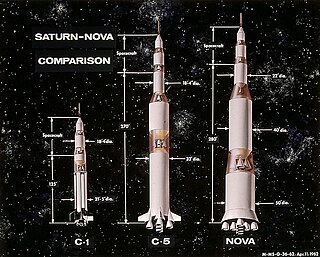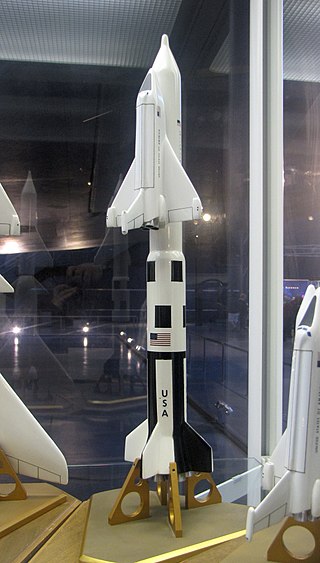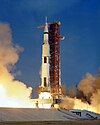Related Research Articles

Saturn-Apollo 1 (SA-1) was the first flight of the Saturn I space launch vehicle, the first in the Saturn family, and first mission of the American Apollo program. The rocket was launched on October 27, 1961, from Cape Canaveral, Florida.

The Saturn family of American rockets was developed by a team of former German rocket engineers and scientists led by Wernher von Braun to launch heavy payloads to Earth orbit and beyond. The Saturn family used liquid hydrogen as fuel in the upper stages. Originally proposed as a military satellite launcher, they were adopted as the launch vehicles for the Apollo Moon program. Three versions were built and flown: the medium-lift Saturn I, the heavy-lift Saturn IB, and the super heavy-lift Saturn V.

Saturn-Apollo 3 (SA-3) was the third flight of the Saturn I launch vehicle, the second flight of Project Highwater, and part of the American Apollo program. The rocket was launched on November 16, 1962, from Cape Canaveral, Florida.
The Saturn I was a rocket designed as the United States' first medium lift launch vehicle for up to 20,000-pound (9,100 kg) low Earth orbit payloads. The rocket's first stage was built as a cluster of propellant tanks engineered from older rocket tank designs, leading critics to jokingly refer to it as "Cluster's Last Stand". Its development was taken over from the Advanced Research Projects Agency in 1958 by the newly formed civilian NASA. Its design proved sound and flexible. It was successful in initiating the development of liquid hydrogen-fueled rocket propulsion, launching the Pegasus satellites, and flight verification of the Apollo command and service module launch phase aerodynamics. Ten Saturn I rockets were flown before it was replaced by the heavy lift derivative Saturn IB, which used a larger, higher total impulse second stage and an improved guidance and control system. It also led the way to development of the super-heavy lift Saturn V which carried the first men to landings on the Moon in the Apollo program.

The N1/L3 was a super heavy-lift launch vehicle intended to deliver payloads beyond low Earth orbit. The N1 was the Soviet counterpart to the US Saturn V and was intended to enable crewed travel to the Moon and beyond, with studies beginning as early as 1959. Its first stage, Block A, was the most powerful rocket stage ever flown for over 50 years, generating 45.4 MN of thrust. However, each of the four attempts to launch an N1 failed in flight, with the second attempt resulting in the vehicle crashing back onto its launch pad shortly after liftoff. Adverse characteristics of the large cluster of thirty engines and its complex fuel and oxidizer feeder systems were not revealed earlier in development because static test firings had not been conducted.

Nova was a series of NASA rocket designs that were proposed both before and after the Saturn V rocket used in the Apollo program. Nova was NASA's first large launcher proposed in 1958, for missions similar to what Saturn V was subsequently used for. The Nova and Saturn V designs closely mirrored each other in basic concept, power, size, and function. Differences were minor but practical, and the Saturn was ultimately selected for the Apollo program, largely because it would reuse existing facilities to a greater extent and could make it to the pad somewhat earlier.

The F-1, commonly known as Rocketdyne F-1, is a rocket engine developed by Rocketdyne. This engine uses a gas-generator cycle developed in the United States in the late 1950s and was used in the Saturn V rocket in the 1960s and early 1970s. Five F-1 engines were used in the S-IC first stage of each Saturn V, which served as the main launch vehicle of the Apollo program. The F-1 remains the most powerful single combustion chamber liquid-propellant rocket engine ever developed.

A modular rocket is a kind of multistage rocket which has components that can interchanged for different missions. Several such rockets use similar concepts such as unified modules to minimize expenses on manufacturing, transportation and for optimization of support infrastructure for flight preparations.

The Common Booster Core (CBC) is an American rocket stage, which is used on the Delta IV rocket as part of a modular rocket system. Delta IV rockets flying in the retired Medium and Medium+ configurations each used a single Common Booster Core as their first stage, while the Heavy configuration uses three; one as the first stage and two as boosters. The Common Booster Core is 40.8 metres (134 ft) long, has a diameter of 5.1 metres (17 ft) and is powered by a single RS-68 engine burning liquid hydrogen and liquid oxygen.

The Saturn II was a series of American expendable launch vehicles, studied by North American Aviation under a NASA contract in 1966, derived from the Saturn V rocket used for the Apollo lunar program. The intent of the study was to eliminate production of the Saturn IB, and create a lower-cost heavy launch vehicle based on Saturn V hardware. North American studied three versions with the S-IC first stage removed: the INT-17, a two-stage vehicle with a low Earth orbit payload capability of 47,000 pounds (21,000 kg); the INT-18, which added Titan UA1204 or UA1207 strap-on solid rocket boosters, with payloads ranging from 47,000 pounds (21,000 kg) to 146,400 pounds (66,400 kg); and the INT-19, using solid boosters derived from the Minuteman missile first stage.

The Saturn-Shuttle was a preliminary concept of launching the Space Shuttle orbiter using a modified version of the first stage of the Saturn V rocket. It was studied and considered in 1971–1972.
The Juno V series of rockets were a design that was proposed in the late 1950s but cancelled. The rockets were multi-stage and, although they failed to reach production, their sections were used in other designs.

The Saturn C-3 was the third rocket in the Saturn C series studied from 1959 to 1962. The design was for a three-stage launch vehicle that could launch 45,000 kilograms (99,000 lb) to low Earth orbit and send 18,000 kilograms (40,000 lb) to the Moon via trans-lunar injection.
Studied in 1965, the same year that Project Gemini started, the Saturn IB-C was simply designed as an orbital launch vehicle like the original Saturn IB. The booster would consist of an ordinary Saturn IB with four Minuteman first stages used as strap-on boosters. The Saturn IB core booster did fly from 1966 until 1975, but never with its Minuteman strap-on boosters.
The Saturn V-3, also known as the Saturn MLV 5-3, was a conceptual heavy-lift launch vehicle that would have utilized new engines and new stages that were never used on the original Saturn V. The Saturn V-3 was studied by the NASA Marshall Space Flight Center in 1965.
Studied in 1968 by Marshall Space Flight Center, the Saturn V-B was considered an interesting vehicle concept because it nearly represents a single-stage to orbit booster, but is actually a stage and a half booster just like the Atlas. The booster would achieve liftoff via five regular F-1 engines; four of the five engines on the Saturn V-B would be jettisoned and could be fully recoverable, with the sustainer stage on the rocket continuing the flight into orbit. The rocket could have had a good launch capability similar to that of the Space Shuttle if it was constructed, but it never flew.
The Saturn V-C, was just like the Saturn V-B, studied in the same year as the V-C, except it would use a S-IVB second stage to get a payload into a higher orbit. A Centaur third stage was optional for deep space missions.
Studied by Douglas Aircraft Company in 1965, this rocket consisted of a whole Saturn IB with 4 strap-on SRBs that have flown on the Titan 3E interplanetary missile carriers. All components of the vehicle have flown, but not together for this concept.

Saturn V is a retired American super heavy-lift launch vehicle developed by NASA under the Apollo program for human exploration of the Moon. The rocket was human-rated, had three stages, and was powered with liquid fuel. Flown from 1967 to 1973, it was used for nine crewed flights to the Moon, and to launch Skylab, the first American space station.

A super heavy-lift launch vehicle is a rocket that can lift to low Earth orbit a "super heavy payload", which is defined as more than 50 metric tons (110,000 lb) by the United States and as more than 100 metric tons (220,000 lb) by Russia. It is the most capable launch vehicle classification by mass to orbit, exceeding that of the heavy-lift launch vehicle classification.
References
- Lowther, Scott, Saturn: Development, Details, Derivatives and Descendants, Work in progress. Available chapters may be ordered directly from Scott Lowther at web site indicated. Accessed at: https://web.archive.org/web/20070521083808/http://www.webcreations.com/ptm.
